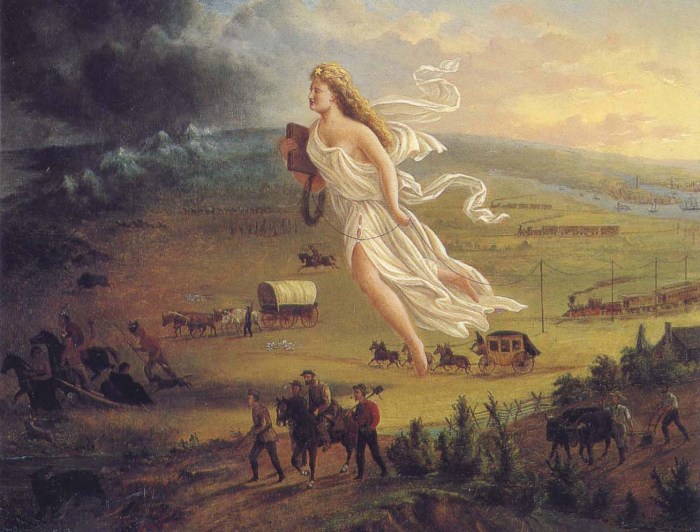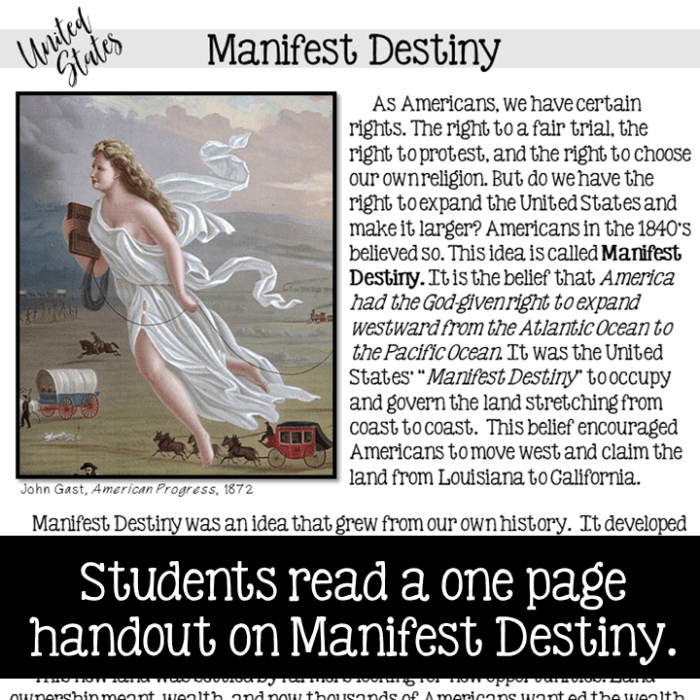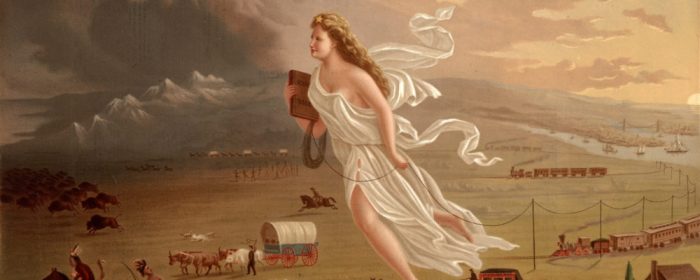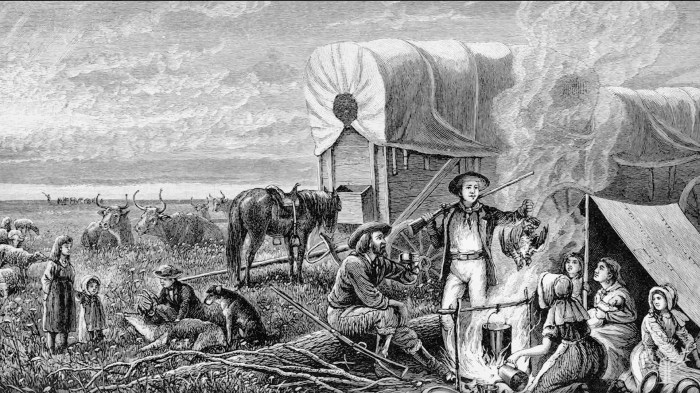Manifest Destiny art analysis reveals a fascinating interplay between artistic expression and historical narrative. From romanticized landscapes celebrating westward expansion to poignant depictions of Native American displacement, these artworks offer a complex and often contradictory portrayal of a pivotal era in American history. Examining the brushstrokes, symbolism, and artistic choices reveals not only the artists’ perspectives but also the evolving national identity and its uneasy relationship with its past.
This analysis delves into the various artistic styles employed—from the idealized landscapes of the Hudson River School to the more critical and nuanced works of later artists. We’ll explore how artists depicted pioneers, settlers, and Native Americans, highlighting the role of gender and race in shaping these visual narratives. The influence of patriotism and nationalism will be examined, alongside the critiques that emerged over time, challenging the dominant narrative of Manifest Destiny and its consequences.
Defining Manifest Destiny in Art

Manifest Destiny, the 19th-century belief in the divinely ordained expansion of the United States across North America, found powerful expression in art. This artistic representation, however, wasn’t a neutral reflection; it actively shaped public perception and fueled the expansionist ideology. Analyzing this art reveals the complex interplay between artistic style, national identity, and the often-brutal realities of westward expansion.
Core Tenets of Manifest Destiny and Their Visual Representation

The core tenets of Manifest Destiny—the belief in American exceptionalism, the right to expand westward, and the inevitability of this expansion—were visually translated through various artistic means. Artists frequently depicted the vast, seemingly untouched landscapes of the West as a promise of abundance and opportunity. The westward movement was often portrayed as a divinely sanctioned mission, with settlers depicted as virtuous pioneers bringing civilization to a wild and untamed land.
This portrayal often minimized or ignored the presence and rights of Indigenous populations already inhabiting these lands.
Dominant Artistic Styles in Manifest Destiny Art
Manifest Destiny art predominantly employed Romantic and Hudson River School styles. Romantic paintings emphasized emotion, individualism, and the sublime beauty of nature, often idealizing the landscapes of the West. The Hudson River School, a specific branch of American Romanticism, focused on detailed and idealized depictions of the American landscape, frequently showcasing its grandeur and potential for development. Later, the rise of realism brought a slightly more nuanced, though still often biased, perspective.
Comparison of Portrayals of Native Americans Across Time Periods
The portrayal of Native Americans in Manifest Destiny artwork evolved over time, reflecting changing societal attitudes. Early depictions often presented Indigenous peoples as obstacles to progress, savage and uncivilized, justifying their displacement. Later works, particularly as public opinion shifted, began to show a more complex, though still often stereotypical, representation, though rarely achieving a truly equitable perspective. The transition from romanticized savagery to a more nuanced (but still often problematic) representation reflects the gradual evolution of public perception, though the inherent biases remained deeply ingrained.
Artistic Representations of Westward Expansion
The physical landscape of the American West played a central role in Manifest Destiny art, serving as a backdrop for the narrative of expansion and progress. Artists employed various techniques to convey the scale, beauty, and perceived potential of the western territories. The symbolic representation of progress, civilization, and wilderness further enhanced the ideological message.
Portrayal of the Western Landscape
Artists often emphasized the vastness and untamed beauty of the western landscape, using techniques like dramatic lighting, expansive compositions, and detailed rendering of flora and fauna to convey a sense of awe and wonder. These paintings often contrasted the seemingly untouched wilderness with the encroaching presence of settlers and their infrastructure, visually illustrating the theme of conquest and transformation.
Symbolism in Paintings

The symbolism employed in Manifest Destiny paintings was crucial in conveying the ideology of westward expansion. Progress was often represented by the construction of railroads, settlements, and farms, while civilization was symbolized by architecture, organized communities, and the presence of religious institutions. The wilderness, conversely, was often portrayed as both beautiful and threatening, a force to be tamed and subdued in the name of progress.
Comparison of Westward Expansion in Paintings and Photographs
Paintings and photographs offer contrasting perspectives on westward expansion. Paintings, often commissioned or created with a specific ideological agenda, presented idealized and romanticized visions. Photographs, while capable of manipulation, generally offered a more realistic, albeit still potentially biased, depiction of the physical realities of settlement and the lives of those involved. The following table highlights key differences:
| Feature | Paintings | Photographs | Notes |
|---|---|---|---|
| Perspective | Often idealized and romanticized; emphasizes grandeur and potential. | More realistic, though still subject to selection bias and manipulation. | Paintings frequently omit harsh realities; photos can still be curated. |
| Subject Matter | Focuses on dramatic landscapes, heroic settlers, and symbolic representations of progress. | Captures a wider range of subjects, including daily life, infrastructure, and the impact on the environment. | Photos allow for more detailed documentation of everyday life. |
| Style | Predominantly Romantic and Hudson River School styles; emphasizes emotion and dramatic effect. | More objective and documentary in style; aims for a factual representation. | Styles reflect different artistic goals and technological capabilities. |
| Bias | Often promotes a narrative of Manifest Destiny, minimizing or ignoring negative consequences. | Still subject to bias in selection and presentation, but potentially less overtly propagandistic. | Both mediums reflect the prevailing societal biases of their time. |
Portrayal of People in Manifest Destiny Art: Manifest Destiny Art Analysis
Manifest Destiny art presented a complex and often contradictory portrayal of the people involved in westward expansion. The depictions of pioneers, settlers, and Native Americans reflected and reinforced existing societal biases and power dynamics. However, some artists began to challenge the dominant narrative, offering alternative perspectives on the westward expansion.
Depictions of Pioneers, Settlers, and Native Americans
Pioneers and settlers were often depicted as heroic figures, embodying courage, determination, and a sense of purpose. They were portrayed as bringing civilization and progress to the wilderness, often overlooking the displacement and violence inflicted upon Indigenous populations. Native Americans, in contrast, were frequently depicted as obstacles to progress, often portrayed in stereotypical and dehumanizing ways. This representation served to justify their displacement and subjugation.
Role of Gender and Race
Gender and race played significant roles in shaping the artistic representations of westward expansion. Women were often portrayed in idealized roles as supportive figures, contributing to the domestic sphere of the expanding settlements. Their contributions beyond domesticity were frequently minimized. Racial stereotypes were deeply embedded in the depictions of Native Americans, reinforcing existing prejudices and justifying acts of violence and dispossession.
Artwork Challenging the Dominant Narrative

While the dominant narrative of Manifest Destiny art celebrated westward expansion, some artists began to challenge this perspective. These artists depicted the negative consequences of expansion, including the displacement and violence against Native Americans, and the environmental destruction caused by westward migration. Their works provided alternative narratives, offering a more critical and nuanced view of this historical period.
The Influence of Patriotism and Nationalism
Manifest Destiny artwork played a crucial role in promoting national pride and patriotism. Artists employed various techniques to evoke feelings of national identity and expansionist ideals, effectively using art as a tool of propaganda to bolster support for westward expansion.
Manifest Destiny Art as Propaganda
The use of art as propaganda to promote Manifest Destiny was widespread. Artists used idealized depictions of landscapes, heroic figures, and triumphant narratives to foster a sense of national unity and purpose. The visual representation of westward expansion as a divinely ordained mission served to legitimize the expansionist agenda and garner public support.
Artistic Techniques Evoking National Identity, Manifest destiny art analysis
Several artistic techniques were employed to evoke feelings of national identity and expansionist ideals. Grandiose landscapes, symbolic representations of progress and civilization, and heroic portrayals of settlers all contributed to the creation of a powerful and persuasive narrative. The use of vibrant colors, dramatic lighting, and detailed compositions further enhanced the emotional impact of these artworks.
Examples of Propaganda in Manifest Destiny Art

- Paintings depicting the westward migration as a triumphant march across the continent.
- Portrayals of settlers taming the wilderness and establishing thriving communities.
- Idealized depictions of American landscapes, emphasizing their beauty and potential.
- Minimization or omission of the violence and displacement suffered by Native Americans.
- The use of religious symbolism to suggest divine sanction for westward expansion.
Artistic Critiques of Manifest Destiny
As time progressed and public opinion evolved, artists began to critique the ideology of Manifest Destiny and its devastating consequences. This shift in artistic representation reflected a growing awareness of the injustices and violence inflicted upon Native Americans during westward expansion. The artistic styles employed also evolved to reflect this changing perspective.
Depiction of Negative Consequences
Artists increasingly depicted the negative consequences of westward expansion, including the displacement, violence, and cultural destruction experienced by Native American communities. These works often presented a stark contrast to the idealized portrayals of the earlier Manifest Destiny art, highlighting the human cost of expansion. Examples include paintings depicting the massacres and forced removals of Indigenous populations, and works that focus on the suffering and loss experienced by Native American communities.
Evolution of Artistic Styles Reflecting Shifting Public Opinion
The evolution of artistic styles mirrored the shifting public opinion on Manifest Destiny. The idealized Romanticism of earlier works gradually gave way to more realistic and critical depictions. The rise of realism and later, social realism, allowed artists to portray the harsh realities of westward expansion with greater accuracy and emotional impact. This shift in style reflects a growing societal awareness of the negative consequences of the expansionist ideology.
Artwork Directly Criticizing Manifest Destiny
One example of artwork directly criticizing Manifest Destiny is [Insert a detailed description of a specific artwork here, including its visual elements and symbolic meaning. For example, you could describe a painting depicting the devastation of a Native American village after a forced removal, or a sculpture representing the loss of cultural heritage. Focus on the specific visual elements and their symbolic meaning to convey the artist’s critique of Manifest Destiny].
The artist’s use of [specific artistic techniques] effectively conveys the brutality and injustice of westward expansion, forcing viewers to confront the dark side of this historical narrative.
Manifest Destiny and the American Identity
Manifest Destiny art has had a lasting impact on the American cultural identity. Its influence can be seen across various artistic mediums, shaping perceptions of national identity, westward expansion, and the relationship between the United States and its Indigenous populations. Contemporary artists continue to engage with the legacy of Manifest Destiny in their work, offering new interpretations and perspectives.
Lasting Impact on American Cultural Identity
The images and narratives presented in Manifest Destiny art have become deeply ingrained in the American cultural consciousness. These representations have shaped how Americans understand their national history, their relationship with the land, and their identity as a nation. Even today, these images continue to influence public perception and inform discussions about national identity and the legacy of westward expansion.
Manifest Destiny in Different Artistic Mediums
Manifest Destiny’s influence extends beyond painting to encompass various artistic mediums. Sculptures often commemorate key figures and events associated with westward expansion, reinforcing the dominant narrative. Literature, through novels and poems, explores the complexities of the era, offering both celebratory and critical perspectives. These diverse artistic expressions collectively contribute to a multifaceted, though often contested, understanding of Manifest Destiny’s impact.
Contemporary Engagements with Manifest Destiny
Contemporary artists continue to engage with the legacy of Manifest Destiny in their work, often offering critical perspectives on the historical narrative. Some artists use contemporary mediums to reinterpret classic Manifest Destiny imagery, highlighting the inherent biases and contradictions. Others create new works that directly address the ongoing consequences of westward expansion, including issues of land rights, environmental degradation, and the ongoing struggles of Native American communities.
This continued artistic engagement ensures that the complex and often troubling legacy of Manifest Destiny remains a subject of ongoing discussion and critical reflection.
Closing Summary
Ultimately, a thorough manifest destiny art analysis underscores the power of art to both reflect and shape historical understanding. By examining these visual representations, we gain a deeper appreciation for the complexities of westward expansion, its impact on the American identity, and the enduring legacy of Manifest Destiny. The diverse artistic interpretations—from celebratory to critical—reveal a multifaceted story, prompting continued dialogue and reevaluation of this pivotal period in American history.
The art itself becomes a testament to the enduring power of visual storytelling and its ability to both commemorate and condemn.
Quick FAQs
What specific techniques did artists use to evoke feelings of national pride in their depictions of Manifest Destiny?
Artists often employed techniques like dramatic lighting, expansive landscapes, and heroic portrayals of pioneers to evoke feelings of national pride and the sense of a divinely ordained mission. Symbolism, such as the American flag or eagles, further reinforced these patriotic themes.
How did photography influence or challenge the artistic representations of Manifest Destiny?
Photography offered a more realistic, less romanticized view of the West, sometimes contradicting the idealized paintings. While initially used to support the narrative of Manifest Destiny, photography later helped reveal the harsh realities of westward expansion, including the displacement and suffering of Native Americans.
Are there any contemporary artists who continue to engage with the themes of Manifest Destiny?
Yes, many contemporary artists continue to explore the legacy of Manifest Destiny, often using it as a lens to examine issues of colonialism, environmentalism, and social justice. Their work frequently challenges the traditional narratives and offers new perspectives on this complex historical period.